AIA Interior Architecture Awards: Seven projects take home the top honors
By Josh Niland|
Wednesday, Feb 9, 2022

Related
Exciting news in the world of interior architecture as the American Institute of Architects has announced this year’s winners of the AIA Interior Architecture Awards.
The list of seven was selected by a five-member panel for their projects’ “design achievement, including sense of place and purpose, community access, ecology and environmental sustainability, and history.” Each winner received a citation from the panel.
Scroll down to see the full list for this year’s award.
Amherst College New Science Center
Payette, Amherst, MA
Project excerpt: "Meticulous craft, layered transparency, and academic connectivity are the hallmarks of Amherst College’s new science center. Situated against the Pelham Hills, the center consists of five buildings within a campus greenway with a central daylight-filled commons that serves as a social heart. Warmly welcoming the entire academic community, the center offers an ultra-transparent window into science. [...] The center, a campus-scaled gesture, is composed of two high-energy laboratory wings tucked into the hillside to the east and three low-intensity pavilions that crawl up the hill toward the college’s academic core. Through its overall organization and detailing, the design promotes transparency and interaction. The laboratories and pavilions all open onto the commons, fostering community and advancing the college’s goal to encourage interaction among students and the sciences." ~ Read more about this project here.

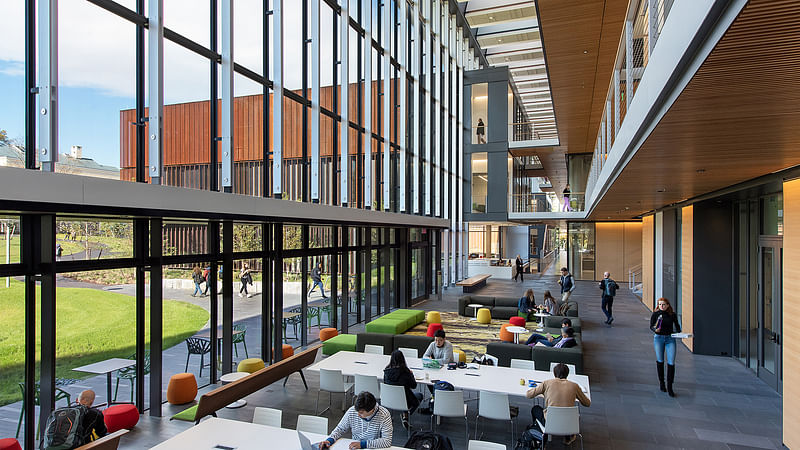
Duke University, Rubenstein Arts Center
William Rawn Associates, Architects Inc., Durham, NC
Project excerpt: "Nicknamed The Ruby, the new Rubenstein Arts Center at Duke University reinvents the role of the arts within a research university. [...] Art-making of all forms is on display in the center at all times, amplifying the university’s mission and inviting all to participate. Each of the studio modules has large glazed openings and a set of acoustically treated barn doors, which facilitate three different modes of operation. They can open fully, enabling strong physical connections between the studios and public spaces, or they can be fully closed for activities that require privacy. The partially opened middle ground offers acoustical privacy with visual transparency through large sections of double-glazed sidelight." ~ Read more about this project here.
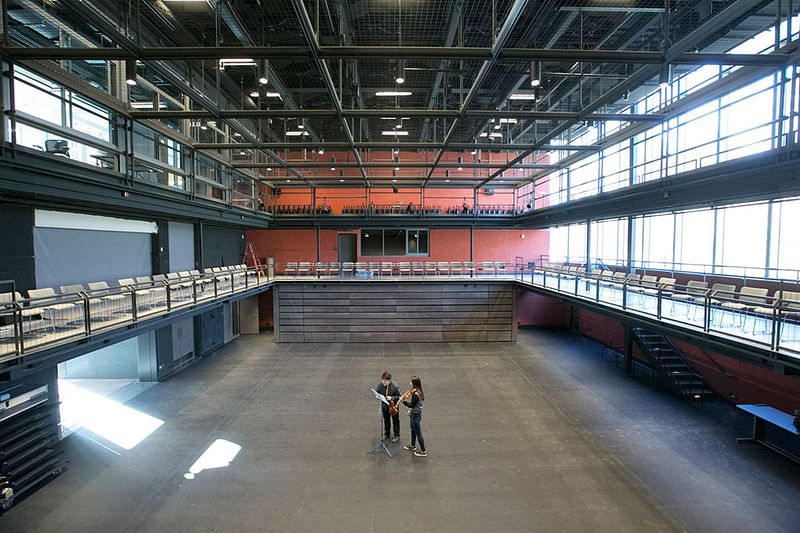
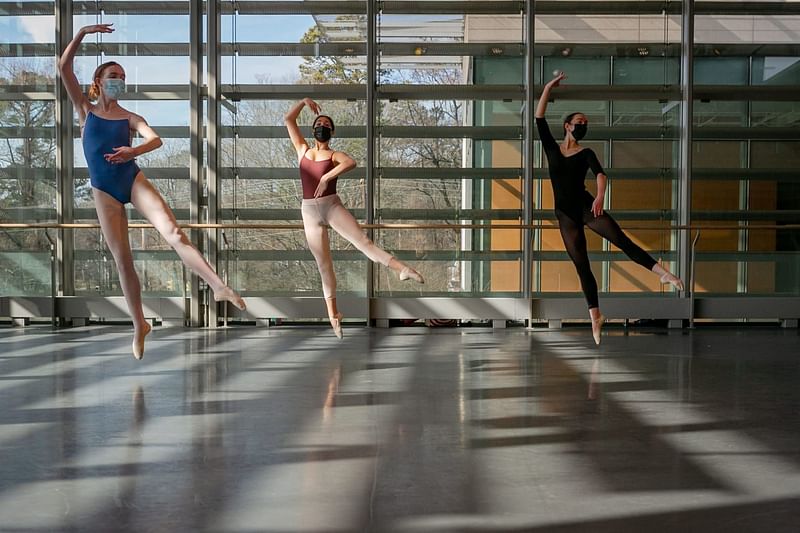
Pennsylvania State University Recital Hall
William Rawn Associates, Architects Inc., State College, PA
Project excerpt: "This project, the first to emerge from Pennsylvania State University's College of Arts and Architecture master plan, replaces an outdated recital hall at the core of the university's School of Music. It adds nearly 14,000 square feet to an existing building and rectifies its predecessor's acoustic and visibility challenges. A key objective of the master plan is to create a new center of gravity for the arts in a precinct of the campus by adding new facilities and broadening opportunities for transparency. [...] The new building opens the School of Music to the campus and the affiliated buildings surrounding it through a new lobby and 40-foot-tall double-skin curtainwall that acoustically isolates the hall from nearby bus traffic. In addition, a terraced outdoor space connects the school's front door and an adjacent theater building while also providing moments of interaction among students and faculty in both programs. Inside, the hall's shape promotes interaction between the audience and student performers. The vineyard-style recital hall, the first at this scale, has audience seating that encloses the stage on four sides to maximize intimacy. No seat in the hall is more than eight rooms from the stage. Seating is decidedly low and requires vomitory entrances from backstage. As such, the audience has an intimate performer's perspective." ~ Read more about this project here.
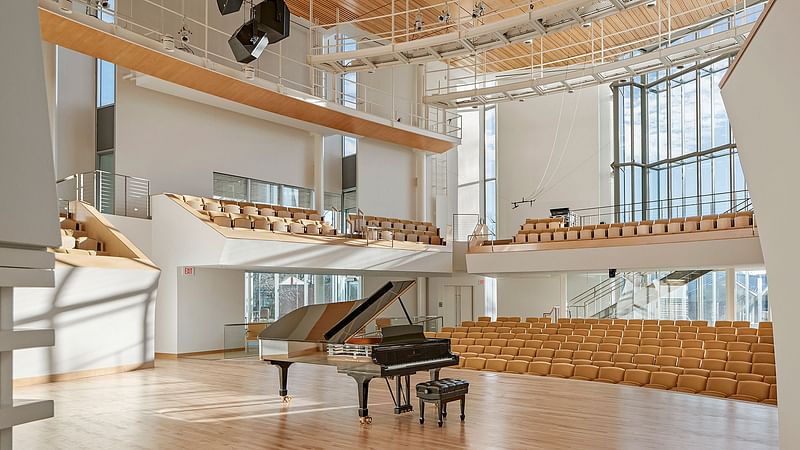
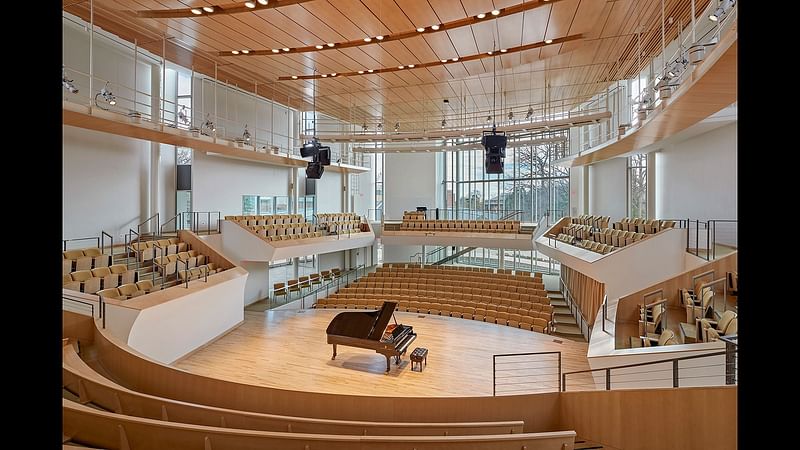
(Cover photo) Two Union Square Repositioning
NBBJ, Seattle, WA
Project excerpt: "Now 30 years old, Two Union Square remains a unique and significant icon in Seattle’s skyline. This project addresses the rapidly evolving needs of the city’s most innovative commercial tenants and the future of work by repositioning all of the building’s public spaces. [...] Advanced technologies, such as VR modeling, were at the core of a design process through which the team developed a highly tactile and emotional experience for the spaces. The fractal wall was computationally designed and engineered, and each of the 1,400 stone pieces used in its construction was optimized to significantly reduce material waste. That same approach was used to develop the wood wave ceiling, which comprises 3,000 curved planks. The team shared 3D files and worked closely with craftspeople and stonemasons to improve their fabrication techniques and map out the intricate installations." ~ Read more about this project here.

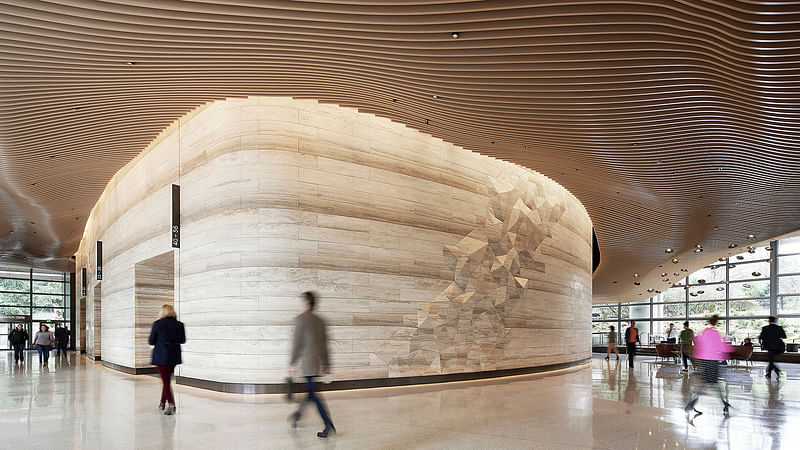
Richardson Olmsted Campus
Deborah Berke Associates, Buffalo, NY
Project excerpt: "This project radically transformed the central portion of Buffalo’s National Historic Landmark Richardson Olmsted Campus into a boutique hotel. Celebrating both the monumental structure originally designed by Henry Hobson Richardson and the surrounding landscape designed by Frederick Law Olmsted, the revitalized building brings new life to an abandoned architectural masterpiece. [...] Now, a new glass and steel entrance serves as a beacon, establishing new connections between the building, the landscape, and a discreet parking area. At night, the new addition glows like a lantern, while the illuminated towers support the building’s stature from a distance. The new entry pavilion relies on light and transparency to demonstrate its contemporary contrast to Richardson’s original masonry building." ~ Read more about this project here.


Geneva Car Barn & Powerhouse
Aidlin Darling Design, San Francisco, CA
Project excerpt: "Through adaptive reuse, the dilapidated Geneva Car Barn and Powerhouse in San Francisco now lives on as a cultural hub that highlights the dynamic interplay between new and old. [...] The design highlights layers of history at the powerhouse, while new program elements were thoughtfully inserted into the shell. Because of the building’s decay and lack of seismic stability, every surface was carefully touched throughout the rehabilitation. All of the brickwork required lead abatement, which was completed with a wire brush, and the bricks were then sealed to preserve the generations of markings. Damaged plaster was repaired sparingly, and the team employed a subtly different shade to help distinguish old from new. Years of graffiti were retained, too, commemorating the building’s recent history as well as its more distant one." ~ Read more about this project here.
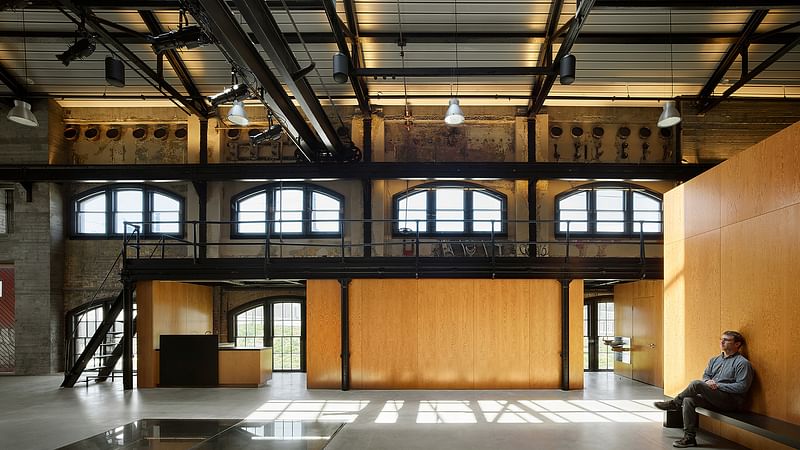

Chicago Architecture Center
Adrian Smith + Gordon Gill Architecture, Chicago, IL
Project excerpt: "The new home for the Chicago Architecture Center, formerly known as the Chicago Architecture Foundation, was carved into an underused retail and exterior space at downtown Chicago’s Illinois Center. The 20,000-square-foot center, widely recognized as the city’s architectural authority, accommodates educational and lecture events, exhibitions, and retail operations. [...] The design of the center’s new headquarters contrasts with the austere classic elements of Mies van der Rohe’s design for the Illinois Center by offering exposed moments of raw architecture. The interior space engages visitors by appealing to both serious architecture scholars and curious visitors. The team was charged with maintaining a profile that is classic and timeless while also provocative and forward-thinking, and it made lively use of color, chiefly red, the center’s primary branding color, throughout. It is employed as a playful wayfinding element, to lend importance to signage, and as an accent on important wall space." ~ Read more about this project here.



RELATED NEWS AIA Interior Architecture Awards: seven projects distinguished with top honors

RELATED NEWS The 2020 recipients of the AIA Interior Architecture Awards


Share
1 Comment
Nam Henderson · Mar 09, 22 4:58 AM
Some particularly lovely adaptive reuse projects!
Comment as :